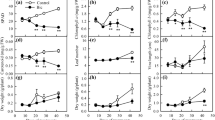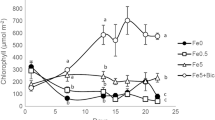Abstract
The role of the leaf apoplast in iron (Fe) uptake into the leaf symplast is insufficiently understood, particularly in relation to the supposed inactivation of Fe in leaves caused by elevated bicarbonate in calcareous soils. It has been supposed that high bicarbonate supply to roots increases the pH of the leaf apoplast which decreases the physiological availability of Fe in leaf tissues. The study reported here has been carried out with sunflower plants grown in nutrient solution and with grapevine plants grown on calcareous soil under field conditions. The data obtained clearly show that the pH of the leaf apoplastic fluid was not affected by high bicarbonate supply in the root medium (nutrient solution and field experiments). The concentrations of total, symplastic and apoplastic Fe were decreased in chlorotic leaves of both sunflower (nutrient solution experiment) and grapevine plants in which leaf expansion was slightly inhibited (field experiment). However, in grapevine showing severe inhibition of leaf growth, total Fe concentration in chlorotic leaves was the same or even higher than in green ones, indicative to the so-called `chlorosis paradox'. The findings do not support the hypothesis of Fe inactivation in the leaf apoplast as the cause of Fe deficiency chlorosis since no increase was found in the relative amount of apoplastic Fe (% of total leaf Fe) either in the leaves of sunflower or grapevine plants. It is concluded that high bicarbonate concentration in the soil solution does not decrease Fe availability in the leaf apoplast.
Similar content being viewed by others
References
Bavaresco L, Giachino E and Colla R 1999 Iron chlorosis paradox in grapevine. J. Plant Nutr. 22, 1589-1597.
Becker R, Grün M and Scholz G 1992 Nicotianamine and the distribution of iron into the apoplasm and symplasm of tomato (Lycopersicon esculentum Mill.). I. Determination of the apoplasmic and symplasmic iron pools in roots and leaves of the cultivar Bonner Beste and its nicotianamine-less mutant chloronerva. Planta 187, 48-52.
Bienfait H F, van den Briel W and Mesland-Mul N T 1985 Free space iron pools in roots. Generation and mobilization. Plant Physiol. 78, 596-600.
Brüggemann W, Maas-Kantel K and Moog P R 1993 Iron uptake by leaf mesophyll cells: The role of the plasma membrane-bound ferric-chelate reductase. Planta 190, 151-155.
Dannel F, Pfeffer H and Marschner H 1995 Isolation of apoplasmic fluid from sunflower leaves and its use for studies on influence of nitrogen supply on apoplasmic pH. J. Plant Physiol. 146, 273-278.
de la Guardia M D and Alcántara E 1996 Ferric chelate reduction by sunflower (Helianthus annuus L.) leaves: influence of light, oxygen, iron-deficiency and leaf age. J. Exp. Bot. 47, 669-675.
Häussling M, Römheld V and Marschner H 1985 Beziehungen zwischen Chlorosegrad, Eisengehalten und Blattwachstum von Weinreben auf verschiedenen Standorten. Vitis 24, 158-168.
Husted S and Schjoerring JK 1995 Apoplastic pH and ammonium concentration in leaves of Brassica napus L. Plant Physiol. 109, 1453-1460.
Kosegarten H U, Hoffmann B and Mengel K 1999 Apoplastic pH and Fe3+ reduction in intact sunflower leaves. Plant Physiol. 121, 1069-1079.
Kosegarten H, Wilson G H and Esch A 1998 The effect of nitrate nutrition on chlorosis and leaf growth in sunflower (Helianthus annuus L.). Eur. J. Agron. 8, 283-292.
Larbi A, Morales F, López-Milán A F, Gogorcena Y, Abadía A, Moog P R and Abadía J 2001 Technical advance: Reduction of Fe(llI)-chelates by mesophyll leaf discs of sugar beet. Multicomponent origin and effects of Fe deficiency. Plant Cell Physiol. 42: 94-105.
López-Milán A F, Morales F, Abadía A, Abadía J 2000 Effects of iron nutrition on the composition of the leaf apoplastic fluid and xylem sap in sugar beet: implication for iron and carbon transport. Plant Physiol. 124, 873-884.
Mengel K 1994 Iron availability in plant tissues-iron chlorosis on calcareous soils. Plant and Soil 165, 275-283.
Mengel K and Bübl W 1983 Verteilung von Eisen in Blättern von Weinreben mit HCO3 ? induzierter Fe-Chlorose. Z. Pflanzenemähr. Bodenkd. 146, 560-571.
Mengel K, Plänker R and Hoffmann B 1994 Relationship between leaf apoplast pH and iron chlorosis of sunflower (Helianthus annuus L.). J. Plant Nutr. 17, 1053-1065.
Morales F, Grasa R, Abadía A and Abadía J 1998 Iron chlorosis paradox in fruit trees. J. Plant Nutr. 21, 815-825.
Nikolic M and Römheld V 1999 Mechanism of Fe uptake by the leaf symplast: Is Fe inactivation in leaf a cause of Fe deficiency chlorosis? Plant and Soil 215, 229-237.
Nikolic M, Römheld V and Merkt N 2000 Effect of bicarbonate on uptake and translocation of 59Fe in grapevine rootstocks differing in their resistance to Fe deficiency chlorosis. Vitis 39, 145-149.
Pfanz H and Oppmann B 1991 The possible role of apoplastic peroxidases in detoxifying the air pollutant sulphur dioxide. In Biochemical, Molecular and Physiological Aspects of Plant Peroxidases. Eds. Laborzewski, H Greppin, C Penel and T Gaspar pp 406-417. University of Geneva, Switzerland.
Pich A and Scholz G 1991 Nicotinamine and the distribution of iron into apoplast and symplast of tomato (Lycopersicon esculentum Mill.) II. Uptake of iron by protoplasts from the variety Bonner Beste and its nicotianamine-less mutant chloronerva and the compartmentation of iron in leaves. J. Exp. Bot. 42, 1517-1523.
Rombolà A D, Brüggemann W, Tagliavini M, Marangoni B and Moog P R 2000 Iron source affects reduction and re-greening of kiwifruit (Actinidia deliciosa) leaves. J. Plant Nutr. 23, 1751-1765.
Römheld V 2000 The chlorosis paradox: Fe inactivation as a secondary event in chlorotic leaves of grapevine. J. Plant Nutr. 23, 1629-1643.
Wilkinson S, Corlett J E, Oger L and Davies W J 1998 Effects of xylem pH on transpiration from wild-type and flaca tomato leaves. Plant Physiol. 117, 703-709.
Yu Q, Tang C and Kuo J 2000 A critical review on methods to measure apoplastic pH in plants. Plant and Soil 219, 29-40.
Author information
Authors and Affiliations
Corresponding author
Rights and permissions
About this article
Cite this article
Nikolic, M., Römheld, V. Does high bicarbonate supply to roots change availability of iron in the leaf apoplast?. Plant and Soil 241, 67–74 (2002). https://doi.org/10.1023/A:1016029024374
Issue Date:
DOI: https://doi.org/10.1023/A:1016029024374




